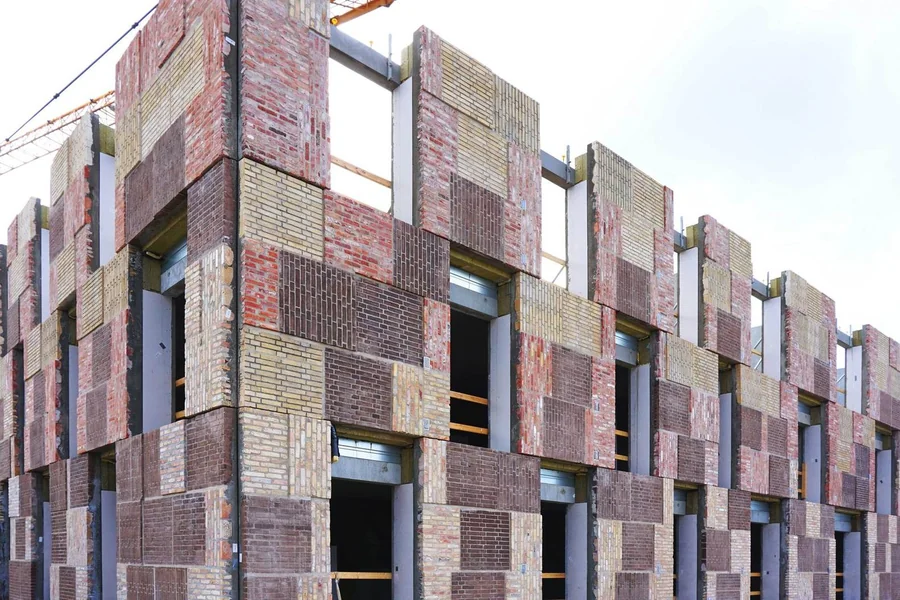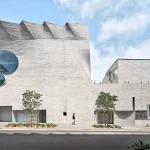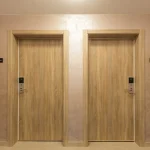With the world adopting sustainability more, architects and interior designers are creating innovative ways of using eco-friendly materials in their buildings. Repurposed and recycled materials used on a wall base are among the most thrilling modern architecture trends. These resources provide a new way to address waste, minimize the carbon footprint, and provide fashionable, practical spaces. Through the reusing and recycling of materials, both architects and home owners will have a role to play towards a more sustainable future without being forced to compromise the design or functionality of the structure.
In this paper, we are going to discuss the advantages of the wall designs offered by repurposed and recycled materials, the most popular types of materials, and how to integrate these sustainable solutions into your home or building project.
The Importance of Sustainability in Architecture
Architectural sustainability is about developing structures and spaces with minimal negative effects on the environment and maximum energy efficiency, resource utilization, and overall environmental performance Unique walls. With the increase in the awareness of people regarding the effects of construction on the environment, there has been an increase in the need to use eco-friendly materials and sustainable designs. As a matter of fact, the construction industry ranks among the worst contributors of wastes in the world with millions of tons of construction materials being thrown away annually.
Recycled and reused materials can solve this issue by reusing the products that would have found their way into landfills. Using these materials in wall constructions, designers and architects are able to decrease the consumption of new raw materials, decrease the production of waste, and produce constructions which meet the increasing necessity in environment-friendly architecture.
Benefits of Repurposed and Recycled Wall Designs
Using repurposed and recycled materials for wall designs offers a host of benefits, not just from an environmental perspective but also in terms of aesthetic appeal, functionality, and cost-effectiveness. Some of the most compelling advantages include:
- Reduced Environmental Impact
The most significant benefit of using repurposed and recycled materials is their positive impact on the environment. Reusing materials reduces the demand for new raw materials, which in turn conserves natural resources and energy. By opting for recycled materials, you also reduce waste sent to landfills and decrease the need for energy-intensive processes, such as mining, logging, or manufacturing.
Additionally, repurposed materials often require less processing than newly manufactured materials, meaning fewer emissions are produced during their production. By choosing sustainable wall designs, you’re helping to lower the carbon footprint of construction projects and contributing to a more sustainable future.
- Unique and Aesthetic Appeal
Repurposed materials can lend a unique, one-of-a-kind charm to wall designs. The beauty of using recycled materials lies in their history and the individuality they bring to a space. Whether it’s reclaimed wood, old brick, or repurposed metal, these materials carry a story and a sense of authenticity that can’t be replicated with new products.
Repurposed wall materials offer a raw, textured appeal that can add character to any room. For example, using reclaimed wood for accent walls creates a rustic, natural look that is perfect for creating a warm, inviting atmosphere. Similarly, old bricks can be used to create an industrial-style wall that adds urban flair to modern spaces. These materials provide not only visual interest but also an emotional connection to the past, making them both sustainable and aesthetically pleasing.
- Cost-Effectiveness
There are chances that repurposed and recycled materials will be cheaper than buying new materials. This is especially so when materials are sourced locally in the form of reclaimed wood, metal or stone in structures being demolished or refurbished. You are able to save some money, by purchasing used materials, without sacrificing quality or design.
Moreover, with the increased demand of sustainable materials, numerous suppliers are now providing recycled materials at reasonable costs, thus making eco-friendly wall designs affordable to both homeowners and businesses. Due to the cost-effectiveness of repurposed and recycled materials, they can be a good choice when projects have a tight budget, particularly during the renovation or update of older buildings.
- Durability and Longevity
Many repurposed materials, such as reclaimed wood and stone, have been weathered by time and use, which often makes them more durable than new materials. For example, reclaimed wood that has aged naturally is often denser and more resilient than new timber. Similarly, old bricks, which have been subjected to years of exposure to the elements, are often more robust than newer, mass-produced bricks.
By using durable, long-lasting materials, you can ensure that your wall designs will stand the test of time, both aesthetically and structurally. These materials tend to age well and become more beautiful with time, making them an ideal choice for creating walls that will endure for generations.
- Supporting Local Economies
When sourcing repurposed materials locally, you’re also supporting local businesses and communities. Many cities and regions have companies specializing in salvaging materials from old buildings, decommissioned factories, and demolished structures. By purchasing locally sourced, recycled materials, you contribute to local economies and promote a more sustainable supply chain.
Supporting these businesses helps reduce the need for long-distance transportation of materials, which further minimizes the environmental impact of construction. It also fosters a sense of connection to the community and the history of the area.
Types of Repurposed and Recycled Materials for Wall Designs
Several types of repurposed and recycled materials are commonly used in wall designs, each offering its own unique qualities. Below are some of the most popular options for creating sustainable wall designs:
- Reclaimed Wood
Reclaimed wood is one of the most popular materials used in repurposed wall designs. This wood is salvaged from old barns, factories, warehouses, and other structures that are being demolished or renovated. The beauty of reclaimed wood lies in its weathered appearance, rich patina, and natural textures, making it ideal for creating a rustic or industrial look.
Reclaimed wood can be used in various ways, such as accent walls, shiplap paneling, or even wall cladding. It’s perfect for creating warmth and character in a space and is often used in modern farmhouse or coastal design themes.
- Recycled Metal
Recycled metal, including steel, aluminum, and copper, is another versatile material that can be repurposed for wall designs. Metal walls create an industrial and modern aesthetic while also being highly durable and low-maintenance. Recycled metal can be used in the form of panels, sheets, or tiles to create textured, reflective surfaces.
Metal walls are often used in urban or contemporary spaces, adding an edgy, polished look. Additionally, metal’s ability to withstand weathering makes it an ideal material for outdoor walls or spaces that require extra durability.
- Recycled Glass
Recycled glass is an eco-friendly material that can be used to create visually stunning wall designs. Glass tiles or panels made from recycled glass offer a sleek, modern appearance and can be used to create backsplashes, mosaic designs, or decorative features. Recycled glass comes in various colors and finishes, allowing for endless design possibilities.
Using recycled glass in wall designs is an excellent way to incorporate sustainable materials into kitchens, bathrooms, or any other space that requires a durable, low-maintenance surface. The reflective properties of glass also help enhance the natural light in a room, making it feel brighter and more open.
- Recycled Brick
Recycled brick is another popular option for wall designs, particularly in industrial or rustic interiors. Salvaged brick from old buildings can be reused to create stunning accent walls that offer a textured, vintage feel. Recycled brick can be used in its original form or refinished to create a more polished appearance.
This material is perfect for creating focal points in living rooms, kitchens, or even fireplace surrounds. Its natural color variations and weathered look bring warmth and authenticity to any space, making it a timeless addition to sustainable architecture.
- Upcycled Paper and Cardboard
Though less common, upcycled paper and cardboard are innovative materials that can be repurposed for wall designs. These materials can be molded or shaped into textured panels or used to create wall art. They are biodegradable, lightweight, and can be printed with custom designs or patterns.
This eco-friendly option is perfect for those seeking to make a bold statement with unique, avant-garde wall designs. Paper and cardboard walls can add an element of texture and artistic flair while contributing to the reduction of waste.
How to Incorporate Repurposed and Recycled Materials into Your Home
To incorporate repurposed and recycled wall materials into your space, consider the following tips:
- Mix and match: Combine different materials for a layered, dynamic look. For example, pair reclaimed wood with metal accents or use recycled glass alongside recycled brick.
- Choose a focal point: Use repurposed materials as accent walls to draw attention to key areas in the room, such as behind a bed or sofa.
- Embrace imperfection: The beauty of repurposed materials lies in their inherent imperfections. Embrace the texture, color variations, and unique characteristics of the materials to create a one-of-a-kind design.
- Consider maintenance: Some recycled materials, like reclaimed wood, may require periodic maintenance to preserve their look and durability. Be sure to understand the care requirements for each material you choose.
Conclusion
Turned wall patterns are an effective solution in building sustainable and beautiful environments. Reclaimed wood, recycled metal, and upcycled glass can help you make the future a greener place and create unique and beautiful wall designs at the same time. Not only do these materials contribute to lowering the environmental impact, but they also bring a certain touch, warmth, and authenticity to any room.
Remaking a house; creating a new area; using old and recycled materials in your walls is an innovative and environmentally friendly method to improve your environment. With limitless design solutions, you can make a room that is not only fashionable but eco-friendly, thus contributing to the planet protection and experiencing the beauty of innovative and ecologically-friendly architecture.






